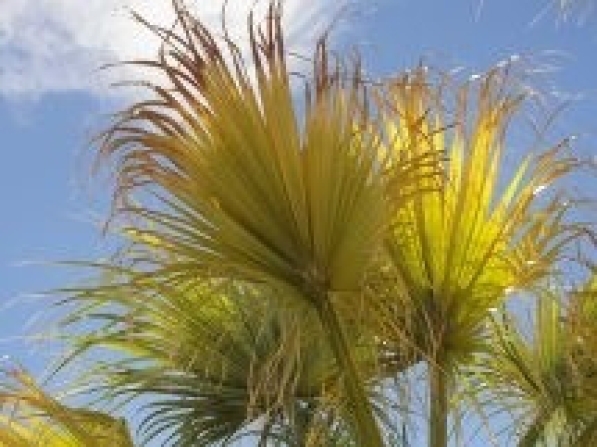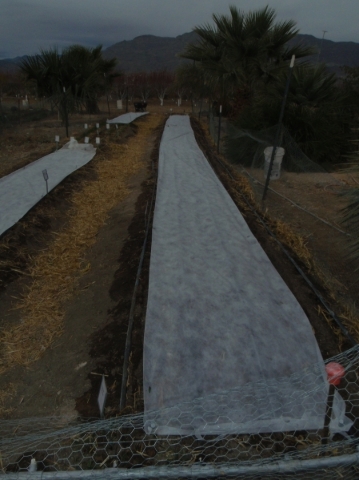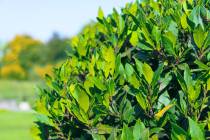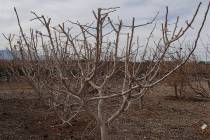Row covers help protect plants from freezing
Q: We use a white, breathable fabric for some of our tender desert plants when there's a chance of freezing temperatures. Can this fabric be left on continuously for long periods of time even though nighttime temperatures are higher than 32 degrees? I was told it could.
A: Yes, you can leave it on! This is a major advantage with these types of products specifically made for protecting plants from light freezes. They are called by several different names, including crop covers, floating row covers and floating row crop covers.
Some background on these products will help you understand them. These covers are flexible, nearly transparent, extremely lightweight and made from fabrics that are typically spun or woven.
They "breathe," allowing light, rain and air movement through them but still capture heat coming from the ground. They transmit so much light that their shading effect on plants is only somewhere around 15 to 20 percent.
They gained fame primarily in commercial vegetable production about 30 years ago for two distinct reasons: protection of vegetables from light frosts and earlier production. When left on permanently during cool weather, they can raise air temperatures under the fabric about 5 to 6 degrees Fahrenheit, which causes vegetables to grow faster, which in turn, means they can be harvested earlier.
Besides protecting young tender plants from freezing temperatures and growing faster, they also provide another valuable advantage: insect protection. In organic production, they are a valuable asset to leafy greens that can be damaged from wind, intense sunlight or chewing insects.
Row crop covers are placed over new seedlings or transplants and keep from blowing away with metal staples and a soil covering the edges. They are also used as a covering for low tunnels used in vegetable production.
Q: Our family owns an unimproved lot at about 8,500 feet in southern Utah. A combination of heavy snowfall, strong winds and disease resulted in blow down of dead and live trees. We are planning to clear the area to reduce the potential of fire and then seed native plants and wildflowers seeds. I cannot find any appropriate seed available to do this.
A: There are seed packets available locally and online labeled as wildflowers. But these are generic wildflowers, and not all are native to our area. You are right to be looking for seed appropriate to your area. Generic types of wildflower seeds should not be used for seeding in semi-primitive or primitive areas.
Introducing plants that are not native will result in future problems. Some non-native plants can invade these areas and "choke out" native plants. This results in multiple, successive future problems for other plants and animals relying on native plants.
Check out this document from the Utah Native Plant Society regarding sources for native seeds. Also download this .pdf from the University of Nevada titled "Living with Fire," which aims at reducing the fire potential for homes located in the Lake Tahoe area of Northern Nevada but has information appropriate to your situation.
Talk with your local forest rangers and decide which of these seed choices would be appropriate for your location. If you have trouble downloading these documents, contact me, and I can help you.
Q: I have three mature California fan palms, aged at least 20 years, planted quite close to each other and located in Mesquite. Two or three years ago, one showed signs of early leaf browning and soon died. Now leaves of the others are quite yellow but stems and new growth at the top are green. I'm afraid they are going the same way as the one that died! Disease?
A: I do not think the yellowing and scorching is directly related to disease. I think it is primarily a soil or plant nutrient problem that will not be solved simply by adding fertilizers. Irrigation might be part of the problem if the trees are watered too often. In your particular case, I think several things may be going on at once.
I'm a big proponent of soil improvement when planting anything in our desert soils. In Mojave Desert soils and soils brought in as fill around homes in housing developments, soil improvement at the time of planting is an absolute must even if you are planting cactus.
If your soil is tan colored or very light brown, there is zero organic matter in that soil. Palms are typically planted without much consideration for any kind of soil improvement. They are planted in tiny holes, the roots surrounded with very little, if any, improved soil. Once planted, the soil surrounding the plant is covered with rock mulch.
In this type of soil environment, roots suffocate and die over time. If they don't die in the first couple of years, they have a great deal of difficulty taking up the proper nutrients from the soil even if fertilizers are applied. They become unhealthy.
The plants react to this poor soil environment by turning yellow. It's not a disease caused by disease organisms directly, but the plant color indicates they are in poor health.
To correct this problem, add organic material to the soil surrounding the roots and improve water drainage and movement of air into the soil. Until this is done, you will see very little improvement to these plants just by adding fertilizer.
In the past, we used a technique called "vertical mulching." It is no longer talked about much anymore, but it was effective. Vertical mulching involved creating vertical holes to a depth of 2 to 3 feet around the plant in the root area. These vertical holes were filled with improved soil.
Vertical holes were created using a high-pressure watering device or a post hole digger. Pull back the rock mulch where you are going to create vertical holes a foot or 2 from the trunk. Create the holes using a post hole digger or water from a high-pressure nozzle to a depth of 2 to 3 feet. Be careful of irrigation lines.
Fill these holes with a 50/50 mixture of the soil you took out of the hole mixed with compost, minus any rocks larger than a golf ball. Create a minimum of four holes around these trees. Use these spots in the future to add fertilizer once a year. Apply more compost on the surface to further improve soil at the surface and put back the rock mulch.
Make sure plastic is not on the soil surface surrounding the plants and under any mulch. Plastic on the soil surface can create similar problems.
Q: How has the Yellow Newtown Pippin apple performed in our climate? I would love to have one if the quality is good here.
A: I published a list of recommended fruit varieties for our climate and made available on my blog. These are fruit tree varieties I have evaluated over a minimum of five years of fruit production. It can be misleading to recommend a variety when it has produced for only one or two seasons.
I am not concerned so much whether this variety of apple tree will grow here or not. It will. My main concern is the quality of the fruit it produces in our climate and soils. Just because you like Macintosh apple you purchased from a local grocery store does not mean that a Macintosh apple grown here will taste the same.
Yellow Newtown Pippin has not had a long enough performance history in our climate to recommend it for the general public. It ripens a little bit before Granny Smith and a month or so before Pink Lady, and this is a good time for apples to ripen in our climate. However, other influences, such as our soils and climate, will impact its quality.
— Bob Morris is a horticulture expert living in Las Vegas and professor emeritus for the University of Nevada. Visit his blog at xtremehorticulture.blogspot.com. Send questions to Extremehort@aol.com.




























